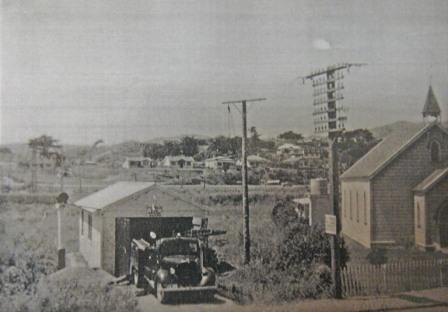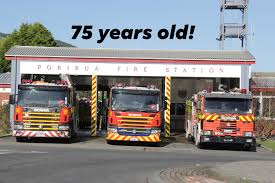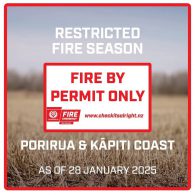History 1950-1971
Page 2
First Fire Station
The No. 1 Priority as far as the Porirua Auxiliary was concerned was to have a fire station of their own, and it was not too long in becoming a reality.
It just so happened that a shed was sitting on the back of Chief Melvilles’ section in Coates Street Linden, which once served as a joinery factory. Now all that was needed was a site to put it on. The site was soon decided upon as there was vacant land just south of the old Porirua Hotel between what was once Greens Funeral Parlour, and the Catholic Church, and by some judicious “fiddling” on the part of Chief Melville and Frm. Moffat, with certain Government Departments, the site was made available. In September-October of 1951 the fire station was erected and duly occupied.
For the first three months of occupation, calls were still lodged with Mr. Moffat who would run down to the Station and turn on the siren which had been shifted from its perch on Mr. Moffat’s roof.
It was in the latter part of 1952 that the single phase siren decided it had reached the end of its service, for on being sounded for a call it promptly flew apart and died.
This was replaced by a “Gent’s 4HP” double ender which was installed and tested by one Frm. Blackbee, and this disturber of the peace (the siren not Frm. Blackbee) may be heard today summoning the volunteers to duty.
 Communications
CommunicationsIn the early years all communications were transmitted through the Porirua Exchange but there was no direct contact between stations. Two hand crank phones were installed. One for speech and one for emergencies, the siren start. In 1952 the Tawa Exchange came into being and virtually became the watch room of the Brigade and the 777 emergency number was introduced.
Communications were further improved by the installation of hand crank phones in strategic points around Porirua. These were enclosed in wooden boxes, and screwed to power poles. To gain access to the phone, a square of glass was broken which allowed the door to open. These were connected to the Tawa Exchange by means of overhead wires and anytime a line fault occurred it more often than not involved the inspection of all the overhead wiring between Tawa and Porirua by driving along the road looking for the point where two wires had twisted together due to slackness in the wires.
It was in 1951 that a Gamewell alarm system was installed at the Tawa Flat station and private fire alarms were connected to it as well as street fire alarm boxes.
This Gamewell system was acquired from Mr. Munster, a retired alarm technician to the Wellington Fire Brigade and was mounted on the wall of Mr. Frazer Savage’s lounge, who was at that time the Deputy Superintendent of the Tawa Flat Volunteers. It remained so mounted for some months while numerous tests and experiments were carried out to ascertain the efficiency of the equipment over long distances. This involved running wires between Mr. Melvilles house, and Mr. Savage’s house, and with the assistance of Mr. Bernie Morse, a P&T employee and also a Sub Off. of the Volunteers, the system was eventually modified to local requirements and gave good service for approximately 10 years.
The Tawa Volunteers acquired army surplus stores wire to reticulate an alarm system through the area; and this was run to the Porirua Station with permission of the N.Z.R. to use their cable duct. The day of laying the cable was set to make use of a special track maintenance train. It was so apparent that the men could work faster on foot, and the cable was laid in very quick time ahead of the train. The laying of the cable was commenced on Sunday morning, and was tested that evening, and was known as the “Phantom Circuit”.




 CHECK ITS ALRIGHT
CHECK ITS ALRIGHT